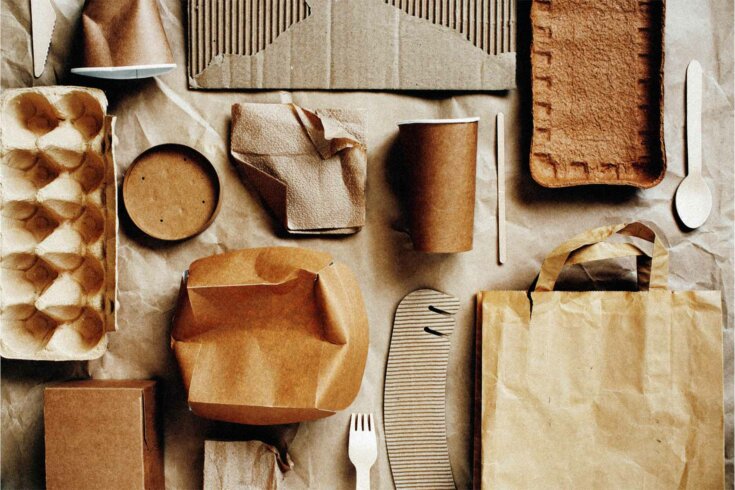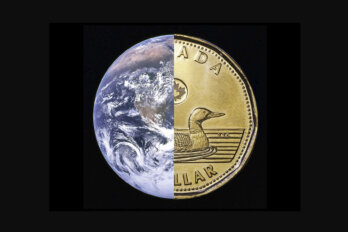Each year, Canadians throw away the equivalent of 300,000 garbage trucks of plastic waste. But only 9 percent of that gets recycled. Many of the items we’ve grown to rely on every day—Tim Hortons coffee cups, grocery-store bags, takeout cutlery—end up in landfills or, worse, in our rivers and lakes. In an attempt to achieve zero plastic waste by 2030, Canada has banned the use of these products, with retailers swapping single-use items for seemingly more sustainable alternatives. But in the months since the regulations were first enacted, environmentalists have expressed concerns over how the increased demand for paper could create an entirely new problem by putting more pressure on Canada’s forests. Is the federal government’s strategy actually working? To find out, we spoke with Toronto Metropolitan University’s Natalia Lumby, whose research focuses on sustainable packaging.
Paper has earned a reputation as a sustainable alternative to plastic. We see it used in paper straws, paper cups, and paper bags. But how will the shift from plastic to paper affect Canada’s pulp industry? Should we be concerned?
I favour looking at the whole system and believe we need to promote sufficiency to stop excessive consumption. The answer is: neither is good. We want to reduce our use of plastic, and we want to reduce our use of paper. Both are limited resources, and both have their own challenges. I believe that paper is viewed favourably for the right reasons. Paper is a renewable resource. We have the capacity to grow trees, we should grow trees, and we can harvest and regrow in a way that you never can with plastic. In future, plastic is going to be a real problem, so the system should shift earlier rather than later.
I am of the mind that if we move away from paper as a natural resource, we’ll actually see a decline in forests. In Canada, few of our forests are privately owned. We actually manage our forests through the government, and there are caps and quotas on how much logging you can do within Canada. Have companies pushed those boundaries inappropriately? Perhaps yes. But generally speaking, from the perspective of the volume of trees, we are well managed. For me, any shift toward paper products is a positive shift [for the] long term, systemically speaking, because trees help with decarbonization in a way that plastic could never do.
A 2014 study that looked at the emissions created by producing a paper bag versus a plastic bag found that producing paper bags can sometimes create more CO2 emissions and use more water and fuel than plastic bags. Are there instances where we should consider using plastic bags?
To consumers in Toronto, it feels like plastic bags have quite suddenly been banned in stores. So is a paper bag better than a plastic bag? Plastic does not biodegrade, so even if the CO2 emissions are higher, it’s neither here nor there, because we are stuck with the plastic bag. It then ends up in the ocean and pollutes our water system, creating issues there. Paper will decompose and is regenerative in a way that plastic currently is not.
But in the short term, locally, the government has banned plastic bags and, in their place, they’ve essentially put in plastic-but-woven bags, which are sold for anywhere from 35 cents to $2.99 instead of the 5 cents you were paying for a plastic bag. I’m most surprised that my local retailers haven’t put out corrugated boxes for consumers. This solution would be one of responsible reuse. Consumers need time to shift their shopping behaviours. They are showing up without bags and buying more of these harmful reusable bags than they could ever need. These bags are awful for the environment if they are not used for a long time repeatedly. These unintended consequences during system shifts are really important. It’s just a matter of extending that legislation a little bit more and seeing that the replacement for plastic bags is something better for the environment. I favour corrugated boxes that the store already has hundreds of and could provide for free.
A Harvard Business Review article looked at how paper packaging is now being unnecessarily added to plastic products to make them seem greener. Do you think we’re creating a new problem by eliminating single-use plastic?
Single-use plastic is being eliminated in very specific places in Canada, but the legislation has not yet reached products. Companies are starting to use paper in their product packaging to seem more environmentally friendly, but because they need to protect their products, they are often needing to use multi-layer substrates. The outer layer is paper, and the inner layers are a variety of plastics and foils. Perhaps you’ve seen things like eco deodorants that will come in a paper-looking box, and then if you take that apart, it’s a multi-layer film, so it’s not paper. This is a form of greenwashing.
Multi-layer substrates are a problem because it’s very difficult to take the layers apart and dispose of them properly, so they end up in landfills. However, the plastic and films industry is working hard to create mono material solutions for packaging that will make them much easier to recycle.
So if it starts with restaurant takeout, I assume that will eventually trickle into other sectors?
I would say my hope for this single-use plastic ban is that instead of targeting the places you find single-use plastic, we learn, as a government and as a society, to change behaviour. At the grocery store, asking shoppers to bring their own bags is a consumer behaviour we are trying to adjust.
We have to, as a society, become more selective about which products we truly need, and that will reduce the impact of packaging. We have to, as a government, invest in the management of the packaging once the product is used. Our legislators are attempting to do that by using extended producer responsibility (EPR).
The shift that I would really like to see is a system shift, a change in some of our defaults. I would love to have to ask for cutlery at a store as opposed to finding it in my bag even though I didn’t ask for it. I would love to have to ask for a to-go cup, because it is normal to sit for a cup of coffee served in a ceramic mug.
In a University of Toronto study that came out earlier this year, researchers examined compostable paper takeout containers and found the presence of toxic “forever chemicals” that aren’t great for our health and for our environment. Is there a lesser of two evils here?
We interact with toxic chemicals all the time. And again, for me, it comes back to legislation. When plastic first came out, it contained chemicals that were not okay. We ended up banning BPA [from certain products], and then plastic became safer. That same cycle will happen with any new substrate you put into the system, so, yes, it’s totally believable to me that they found those chemicals, because we have to develop a whole new process to make paper plates. When we’re creating these new substrates now, I think they need to go through that shift in order to find a new solution. Legislation and rigorous testing will help keep everyone safe as these products are developed. Ideally, this will prevent these negative iterations of the process from being released to consumers.
Late last year, Tim Hortons announced plans for new packaging made from wood fibres. Is it actually a decent solution?
Yes, I think pulp fibre for the lids is a good solution, given the limited options that they have. I think where I worry is on the collection side. People are already confused about whether the cup is paper or not. I don’t think the new Tim Hortons cup is changing—it’s just the lid. So it’s about consumers knowing where to put the cup and where to put the new lid. This will require some consumer education. As long as the collection is well executed, then I think it’s a viable option.
Tim’s also experimented with a pilot project introducing a reusable cup that you can bring back and trade in. Is that better than the plastic grocery-store bags situation?
Reusables are an emerging hot topic in research. I think they’re a great solution as long as they think through the incentive to bring these containers back for actual reuse. Coca-Cola Freestyle is a good example of this. They made the package the payment device. There’s a radio frequency identification (RFID) chip in the durable plastic bottle, and the refill system works by putting your bottle into the dispenser, and then you fill it up with whatever Coca-Cola product you prefer. When you put your bottle down, it knows to charge you for that coke. It acts almost like a wallet. This is why, instead of consumers buying many durable bottles, they keep returning with one, which promotes the sustainable behaviour we want to see.
How much more expensive is it to use sustainable packaging? These multi-million-dollar companies can surely afford to redesign their packaging, but what happens to your local mom-and-pop shop?
Sustainable packaging is currently more expensive, because it’s not at scale. So as we legislate toward sustainable packaging to increase this scale-up, will some businesses struggle? Yes. But I think, for the most part, one good thing about capitalism is where there is demand, the market will flock, and a shift will occur. Markets will drive toward the solutions that are allowed, and this is why legislation is really important. People in consumer packaging will tell you that an elective approach to sustainability, which means that they have to either bear the cost or pass it to their consumer, is difficult. The minute we legislate a specific solution to be more sustainable, we level the playing field, allowing companies to make those investments. The large consumer goods companies that drive plastic pollution and packaging pollution can have a lot of impact. It is not that they don’t have the capability of switching. It’s that they don’t have the capability of being the only one who is switching.
Do you have any thoughts on why we, as a society, especially in North America, are so reliant on single-use everything?
I think we have a hustle culture, as well as a growing disparity in income—even in Canada, which we like to think is a little bit socialist. I think all of these behaviours are bandwidth problems. I am by no means a perfect consumer at all, and I use single-use things as well. When does it happen? It happens when I don’t have enough time to drop off my kids at school, and I haven’t had a chance to have a coffee and I’ve got a meeting at 8:45 a.m. These things cascade, and I have to use the option that is available to me. Our culture of success equals constant work, and the value of humans equals making more money. You cannot get away from this being a philosophical discussion. We won’t get away from single-use anything if we don’t have time to wash our dishes. What we’re left with are solutions that are a bit better, but they’re never going to be perfect, because the problem is not the packaging.





